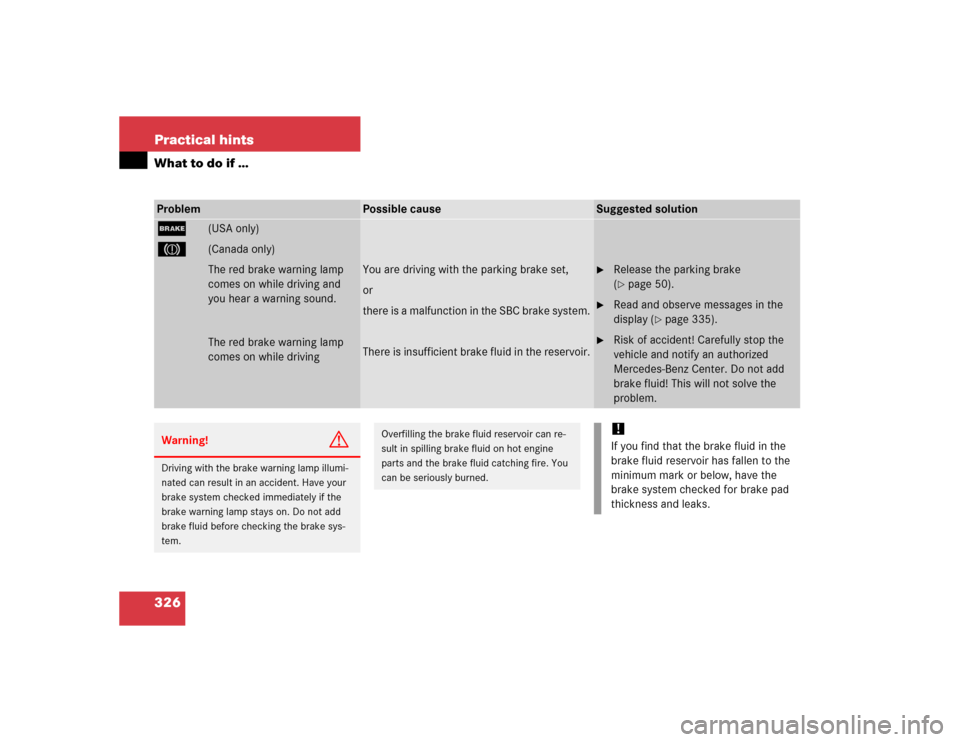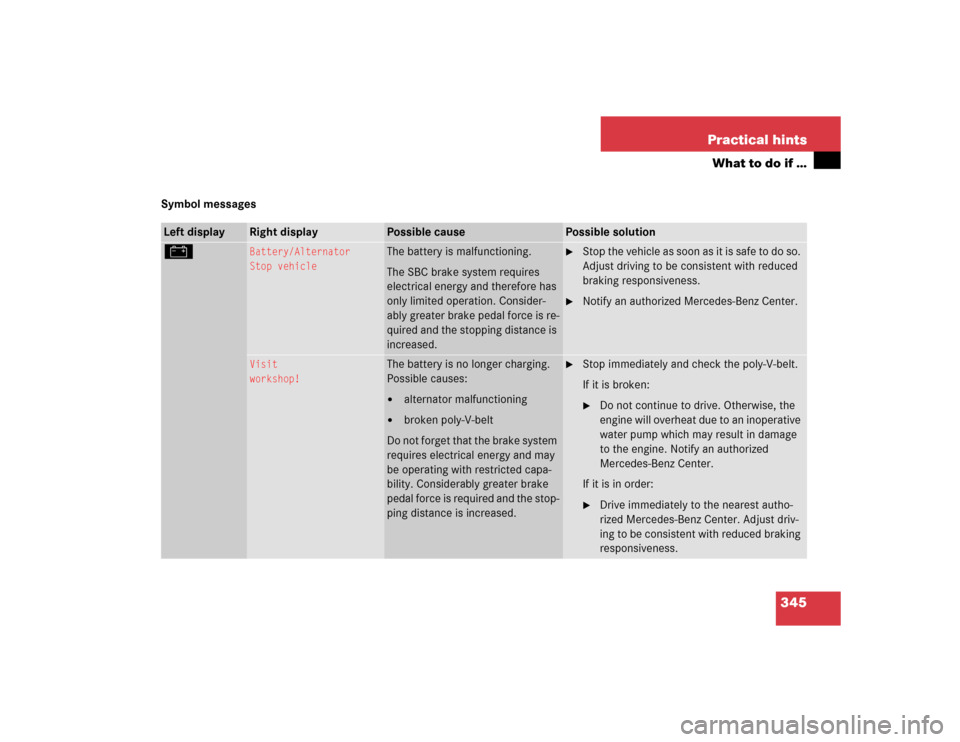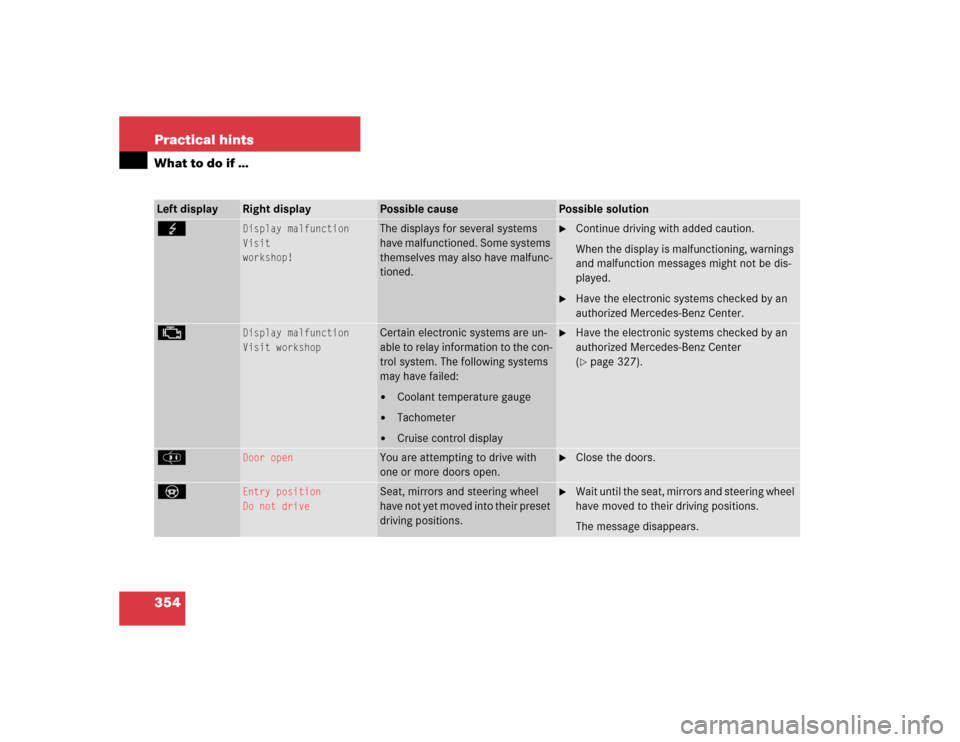Page 328 of 474

326 Practical hintsWhat to do if …Problem
Possible cause
Suggested solution
;
(USA only)
3
(Canada only)
The red brake warning lamp
comes on while driving and
you hear a warning sound.
The red brake warning lamp
comes on while driving
You are driving with the parking brake set,
or
there is a malfunction in the SBC brake system.
There is insufficient brake fluid in the reservoir.
�
Release the parking brake
(�page 50).
�
Read and observe messages in the
display (
�page 335).
�
Risk of accident! Carefully stop the
vehicle and notify an authorized
Mercedes-Benz Center. Do not add
brake fluid! This will not solve the
problem.
Warning!
G
Driving with the brake warning lamp illumi-
nated can result in an accident. Have your
brake system checked immediately if the
brake warning lamp stays on. Do not add
brake fluid before checking the brake sys-
tem.
Overfilling the brake fluid reservoir can re-
sult in spilling brake fluid on hot engine
parts and the brake fluid catching fire. You
can be seriously burned.
!If you find that the brake fluid in the
brake fluid reservoir has fallen to the
minimum mark or below, have the
brake system checked for brake pad
thickness and leaks.
Page 335 of 474

333 Practical hints
What to do if …
Problem
Possible cause
Suggested solution
H
The yellow warning lamp for the
tire pressure monitoring system
comes on.
The tire pressure monitoring system de-
tects a loss of pressure in at least one tire.
�
Bring the vehicle to a halt, avoiding
abrupt steering and braking maneuvers.
Observe the traffic situation around you.
�
Take note of the messages in the multi-
function display.
The warning lamp goes out once the tire in-
flation pressure monitor has been reactivat-
ed after the tire inflation pressure has been
corrected.
Warning!
G
When the tire pressure monitoring system
warning light is lit, one or more of your tires
is significantly under-inflated. You should
stop and check your tires as soon as possi-
ble, and inflate them to the proper pressure
as indicated on the vehicle’s tire information
placard. Driving on a significantly under-in-
flated tire causes the tire to overheat and
can lead to tire failure.
Under-inflation also reduces fuel efficiency
and tire tread life, and may affect the vehi-
cle’s handling and stopping ability. Each tire,
including the spare, should be checked
monthly when cold and set to the recom-
mended inflation pressure as specified in
the vehicle placard and owner’s manual.
iThe recommended tire inflation pres-
sures for your vehicle can be found on
the tire placard on the driver’s door
B-pillar, not in the owner’s manual.
Page 337 of 474

335 Practical hints
What to do if …
Vehicle status messages in the multi-function display
Warning and malfunction messages ap-
pear in the in the multifunction display lo-
cated in the instrument cluster.
Certain warning and malfunction messag-
es are accompanied by an audible signal.
Address these messages accordingly and
follow the additional instructions given in
this Operator’s Manual.
Selecting the vehicle status message
memory menu in the control system
(�page 143) displays both cleared and
uncleared messages.
High-priority messages appear in the mul-
tifunction display in red color.Certain messages of high priority cannot
be cleared from the multifunction display
using the reset button (
�page 24) or but-
ton j, k, ÿ, or è on the
multifunction steering wheel.
Other messages of high priority and mes-
sages of less immediate priority can be
cleared from the multifunction display us-
ing the reset button or button j, k,
ÿ, or è on the multifunction steer-
ing wheel. They are then stored in the vehi-
cle status message memory (
�page 143).
Remember that clearing a message will not
correct the condition that caused the mes-
sage to appear.
Warning!
G
All categories of messages contain impor-
tant information which should be taken note
of and, where a malfunction is indicated, ad-
dressed as soon as possible at an autho-
rized Mercedes-Benz Center.
Failure to repair condition noted may cause
damage not covered by the Mercedes-Benz
Limited Warranty, or result in property dam-
age or personal injury.Warning!
G
No messages will be displayed if either the
instrument cluster or the multifunction dis-
play is inoperative. Contact your nearest au-
thorized Mercedes-Benz Center.
Page 338 of 474
336 Practical hintsWhat to do if …On the pages that follow, you will find a
compilation of the most important warning
and malfunction messages that may ap-
pear in the multifunction display.
For your convenience the messages are di-
vided into two sections:�
Text messages (
�page 337)
�
Symbol messages (
�page 345)
iSwitching on the ignition causes all in-
strument cluster lamps (except high
beam headlamp indicator lamp and
turn signal indicator lamps unless acti-
vated) as well as the multifunction dis-
play to come on. Make sure the lamps
and the multifunction display are in
working order before starting your jour-
ney.
Page 339 of 474
337 Practical hints
What to do if …
Text messagesLeft display
Right display
Possible cause
Possible solution
ABC
Drive carefully!
The capability of the ABC system is re-
stricted. This can impair handling.
�
Do not exceed a speed of 50 mph
(80 km/h).
�
Visit an authorized Mercedes-Benz Center
as soon as possible.
The vehicle is losing oil.
�
Stop your vehicle as soon as it is safe to
do so.
Stop,
car too low
The car is parked on an extremely un-
even surface.
�
Press the vehicle level control button to
select level 2 (
�page 222).
ABC is malfunctioning.
�
Stop and press the ABC button to select a
higher vehicle level (
�page 222).
�
Do not turn steering wheel too far to avoid
damaging the front fenders.
�
Listen for scraping noises.
�
Do not exceed a speed of 50 mph
(80 km/h).
�
Visit an authorized Mercedes-Benz Center
as soon as possible.
Page 347 of 474

345 Practical hints
What to do if …
Symbol messagesLeft display
Right display
Possible cause
Possible solution
#
Battery/Alternator
Stop vehicle
The battery is malfunctioning.
The SBC brake system requires
electrical energy and therefore has
only limited operation. Consider-
ably greater brake pedal force is re-
quired and the stopping distance is
increased.
�
Stop the vehicle as soon as it is safe to do so.
Adjust driving to be consistent with reduced
braking responsiveness.
�
Notify an authorized Mercedes-Benz Center.
Visit
workshop!
The battery is no longer charging.
Possible causes:�
alternator malfunctioning
�
broken poly-V-belt
Do not forget that the brake system
requires electrical energy and may
be operating with restricted capa-
bility. Considerably greater brake
pedal force is required and the stop-
ping distance is increased.
�
Stop immediately and check the poly-V-belt.
If it is broken:�
Do not continue to drive. Otherwise, the
engine will overheat due to an inoperative
water pump which may result in damage
to the engine. Notify an authorized
Mercedes-Benz Center.
If it is in order:
�
Drive immediately to the nearest autho-
rized Mercedes-Benz Center. Adjust driv-
ing to be consistent with reduced braking
responsiveness.
Page 350 of 474

348 Practical hintsWhat to do if …Left display
Right display
Possible cause
Possible solution
USA only:;Canada only:3
Reduced
brake effect
Visit
workshop
The SBC brake system is in emer-
gency operation mode. Consider-
able brake pedal force is required
and the stopping distance is in-
creased.
�
Continue driving with added caution.
�
Adjust driving to be consistent with reduced
braking responsiveness.
�
Visit an authorized Mercedes-Benz Center im-
mediately. Adjust driving to be consistent
with reduced braking responsiveness.
Warning!
G
Driving while these messages are displayed
can result in an accident. Have your brake
system checked immediately.
If there is a malfunction in the SBC brake
system, we recommend that the vehicle be
transported with all wheels off the ground
using flatbed or appropriate wheel lift/dolly
equipment.
A tow bar must be used if circumstances do
not permit the use of the recommended
towing methods and the vehicle requires
towing with all four wheels on the ground.
Towing the vehicle with all four wheels on
the ground is only permissible for distances
up to 30 miles (50 km) and at a speed not to
exceed 30 mph (50 km/h). For more infor-
mation, see “Towing the vehicle”
(�page 408).
If the SBC brake system enters its emergen-
cy operation mode, the driver must apply
significantly greater brake pedal pressure
and depress the pedal much further than
normal to obtain braking effect.
If necessary, apply full pressure to the brake
pedal. Brakes are only applied to the front
wheels. Stopping distance is increased!
Page 356 of 474

354 Practical hintsWhat to do if …Left display
Right display
Possible cause
Possible solution
G
Display malfunction
Visit
workshop!
The displays for several systems
have malfunctioned. Some systems
themselves may also have malfunc-
tioned.
�
Continue driving with added caution.
When the display is malfunctioning, warnings
and malfunction messages might not be dis-
played.
�
Have the electronic systems checked by an
authorized Mercedes-Benz Center.
±
Display malfunction
Visit workshop
Certain electronic systems are un-
able to relay information to the con-
trol system. The following systems
may have failed:�
Coolant temperature gauge
�
Tachometer
�
Cruise control display
�
Have the electronic systems checked by an
authorized Mercedes-Benz Center
(�page 327).
J
Door open
You are attempting to drive with
one or more doors open.
�
Close the doors.
_
Entry position
Do not drive
Seat, mirrors and steering wheel
have not yet moved into their preset
driving positions.
�
Wait until the seat, mirrors and steering wheel
have moved to their driving positions.
The message disappears.